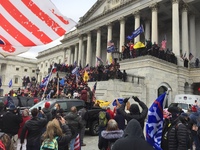The Medium(s) of Memory
This week we talked about the medium(s) of memory. In one sense, medium refers to the media in which memory appears, for example newspapers, television, and social media. We read an essay by Dayan and Katz that explained how television shapes the collective memory through the editing and presentation of "events." Robin Wagner-Pacifici also helped us to think about the nature and construction of events in her essay "Memories in the Making." Finally, we considered Paul Connerton's discussion of the difference between memories that are inscribed in narrative and memories that are incorporated through embodied practices. This highlights another meaning of the word medium - the relationship between the content of the memory and the form in which it appears.
On January 6, 2021, former U. S. President Donald Trump gave a speech to a group of his supporters a short distance away from the U. S. Capitol, where Congress was confirming the results of the 2020 election in which Joe Biden was elected President. This speech was planned for many weeks, and Trump repeatedly called for his supporters to join him in Washington to demonstrate their unhappiness that Trump had lost the election. Trump’s refusal to concede the election was a significant event, highlighting that “alternative facts” and emotionally-charged false claims had become a major touchstone in right-wing politics. Trump’s speech drove the crowd into a frenzy, ultimately resulting in a large group storming the Capitol. When this infamous insurrection occurred, the events that rapidly unfolded were not only broadcast by traditional televised media, but were also shared widely across social media platforms by members of the crowd. The event quickly became priority broadcasting in the United States and abroad.
In the excerpt of the book “Media Events: The Live Broadcasting of History” (1994) found in “The Collective Memory Reader” (Olick, Vinitzky-Seroussi, & Levy, 2011), authors Dayan and Katz discuss the influence of media events on collective memory. Media events are a specific type of broadcast which are characterized by four qualities: they are broadcast live, they occur outside of the traditional newsroom, they interrupt regular broadcasting, and they are preplanned events (Dayan & Katz, 1994, as cited in Olick, Vinitzky-Seroussi, & Levy, 2011, p. 362). While Dayan and Katz (1994) specifically speak about televised media events, the insurrection that occurred at the U. S. Capitol highlights the fact that it is crucial to also consider the influence of media events broadcast on social media in the contemporary age. Social media allows for competing narratives to gain traction and legitimacy because social media can provide a platform to “edit and reedit collective memory” to cater to specific interests (Dayan & Katz, 1994, as cited in in Olick, Vinitzky-Seroussi, & Levy, 2011, p. 363). Uploaded by EP.
Mediums, Messages, and Casey Neistat
Marshall McLuhan's declaration that "the medium is the message" is specific enough to appear salient in discussions about collective memory but generalized to the point of not necessarily offering much in the way of guidance if a person is struggling to understand the concept. The statement works as a tautological observation, not dissimilar to "it is what it is" or "keep on keeping on." That doesn't devalue its worth as a discussion point about mediums and messages, but it does require further distinction if any conclusions are to be made about one or the other in a contemporary setting. For example, Casey Neistat is a YouTube folk hero in 2022, but he was a niche filmmaker whose most significant credit was a short-lived 2010 HBO series. Neistat launched his daily vlog on YouTube in 2015, creating a touchstone in social media and legitimizing the act of pointing a camera at oneself for fun and profit. Mostly profit, as Neistat's "professionalization" of vlogging created an industry unto itself within the internet by blurring the line between medium and message. Neistat contextualizes his personality within the context of a social site dedicated to personal branding, all of which serve his cultural significance in popular media. Casey Neistat became a "media event," paraphrasing Daniel Dahan and Elihu Katz, broadcasting his story, or "history." — REL
Anna Doing Dishes at the Aparthotel
This image depicts a feminine-presenting person doing dishes. I chose this photo in particular because of its amateur quality and the ordinariness of the moment depicted in it, which give it a universal quality. Paul Connerton discusses the difference between memory practices that are “inscribing” vs. “incorporating.” His examples of incorporating practices include swimming and the performance of culturally appropriate postures. These are things that are formally or informally taught and which people obviously remember how to do, without remembering the moment they were taught to do them. Connerton discusses posture in particular as an oft-gendered performance of social ranking. His mention of gender, while not central to his argument, brought to mind a set of what I believe to be incorporated practices of memory: household cleaning tasks.
Connerton states: “ . . . habit eventually brings it about that each event precipitates an appropriate successor . . . without reference to the conscious will” (Olick et al. 342).
This concept may be readily grasped by any person who has been in the position of trying to teach another adult (who, through some circumstance, gender-related or otherwise, was never taught) how to do dishes or how to clean a bathroom. It feels difficult and unnatural to articulate the minutiae: this is how to scrub, yes, you need to clean the back of the plate too, this is how much cleaning product to use, and then you have to empty the sink, and then, and then, ad nauseum. When one has performed the same steps in the same order a thousand times, as Connerton suggests, the conscious mind scarcely enters into the equation. I believe Connerton is saying, in this excerpt, that those memory practices which are incorporated, as opposed to those which are inscribed, suffer the inherent disadvantage of being somewhat invisible, even to their own actors, and therefore difficult to transmit to others. I think it is worthwhile to consider whose labour tends to be documented and whose tends to live invisibly in the body.
-Submitted by Ira
The image I have selected for this archive portrays a young woman wearing a traditional Ukrainian dress and lounging in a tree. The text roughly translates to "how could you not love my country!", indicating that it may be a tourism advertisement. This image was retrieved from "Internet Archive", an online public library with a mission of providing universal public access to all knowledge. This particular photo belongs to a collection on Internet Archive created by SUCHO. SUCHO is an acronym for Saving Ukrainian Cultural Heritage Online. Started by a group of self-identified cultural heritage professionals (librarians, archivists, researchers, and programmers) who aim to work collaboratively with the Ukrainian public to digitally archive Ukrainian heritage in the wake of the recent Russian attacks. Some Ukrainian museum sites have already gone offline due to issues with server connections that could potentially be destroyed altogether. To prevent the loss of Ukrainian heritage and culture and the memory of it, SUCHO has brought together around 1,000 volunteer archival professionals who are working on scouring the internet for photos, writings, music, and other data that are relevant to both collective and individual Ukrainian heritage. The archive collection currently has about 14,800 items. These images and writings include Ukrainian monuments, political and cultural figures, famous paintings, and well-known advertisements that the Ukrainian collective can largely relate to. It also includes more tender memories, such as weddings, sports games, diary entries, and personal photos.
The collective coming together-ness both of Ukrainians and people who are in support of Ukraine is made even more evident through digital forms. As Dayan and Katz state, some historical events are so monumental that they completely halt everyday life and demand society’s attention (362). Society becomes mandatorily obliged to view the event. In commemorative forms such as SUCHO, “the audience is given an active role in the celebration” (362), whereby anyone is able to scour the internet for Ukrainian archives and play a role in documenting them. The coupling of the current appalling Russian military efforts combined with the collective memory of the role that Russia has played sociopolitically throughout history plays a crucial role in evoking “a renewal of loyalty to the society and its legitimate authority” (362) whereby the global world seeks to support Ukraine’s sovereignty against Russia - AM.
Menomics of a City
The HighLevel Bridge has been a major landmark of Edmonton since its construction in 1913. For over a century it has served the role as an artery, linking the core. To celebrate its centennial, LED lights were fixed onto the bridge above the pedestrian thoroughfares and the concrete supports above the water. Those lights now serve a new role for the bridge to perform. “‘Light the Bridge’ celebrates and builds community spirit in Edmonton. The bridge lights are a beautifying element to our cityscape, a symbol of solemnity for locals, and part of our Edmonton story. They can also be used to help represent Edmonton and share our story with national and international audiences.” (https://www.edmonton.ca/attractions_events/schedule_festivals_events/light-the-bridge)
Date 2022/ Reason / Colours
March 10 / MacEwan Pride Week / Rainbow
March 11 / National Day of Observance, COVID-19 / White
March 12 / Independence Day of Mauritius / Red,Blue,Yellow,Green
Nearly every night the bridge is used as a commemorative ceremony. In this way, Edmontonians are reminded of their identity as locals and as global citizens within a “connective autobiography”.(Connerton quoted in Olick at al, 2011: pg 338). The colours are clearly symbolic depictions, used as the essential communication to execute the event(s) relevant to the time. The calendar then, as Connerton would put it, the “choreography of authority”(Olick at al, 2011: pg 340). Therefore the bridge is performing mnemonics in a stylistic fashion, posturing the master narrative of Edmonton and keeping the past and present memory alive. Used in this way the bridge is acting as an incorporating practice to solidify the cultural specificity of Edmonton and its international population. On a weekly basis the bridge transmits habitually only during dark hours, the only time it can “sustain the particular activity”(Connerton quoted in Olick at al, 2011: pg 338), re-enactments to honour the memories of someone or something. The biggest reason for why this performance works successfully is due to the history and location of the bridge, the sense of place it holds. Its existence is central, and the mode of acquisition is commuting, people literally pass through or under the body of truths generally established, valid and fundamental. Forcing upon us the capacity to remember - RB




